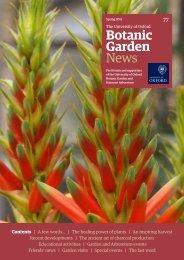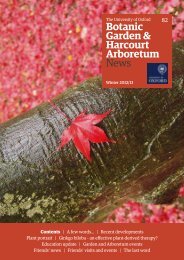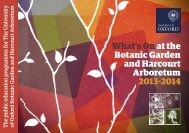Autumn/Winter 2011/12 - Harcourt Arboretum - University of Oxford
Autumn/Winter 2011/12 - Harcourt Arboretum - University of Oxford
Autumn/Winter 2011/12 - Harcourt Arboretum - University of Oxford
Create successful ePaper yourself
Turn your PDF publications into a flip-book with our unique Google optimized e-Paper software.
4<br />
Botanic Garden News | No. 79<br />
Invaluable volunteers<br />
by Alison Foster,<br />
Mary Isaac and Tom Price<br />
“It was an enjoyable and relaxing<br />
experience, nice people to chat<br />
to and share garden stories with.<br />
Now I’m doing more volunteering.<br />
It’s not like weeding at home, the<br />
surroundings make it worthwhile!”<br />
Isabelle Kandler, weeder<br />
Victorious over the Nothoscordum: volunteers (l-r) Rose Holman, Ruth Sutherland,<br />
Sally Strang and Isabelle Kandler<br />
For several years the clamor from the Friends to get their hands dirty<br />
and volunteer in the Garden and <strong>Arboretum</strong> has been steadily growing.<br />
With the arrival <strong>of</strong> the new Senior Curator Alison Foster and <strong>Arboretum</strong><br />
Curator Ben Jones in spring <strong>2011</strong>, we started thinking about ways the Garden and<br />
<strong>Arboretum</strong> could welcome more volunteers. <strong>2011</strong> is designated the International<br />
Year <strong>of</strong> Volunteers, building on the success <strong>of</strong> the first IYV held in 2001, and<br />
in July PlantNetwork, the national network <strong>of</strong> botanic gardens, arboreta and<br />
other documented plant collections, organised a conference on Volunteers<br />
in Botanic Gardens and Arboreta. The timing was perfect as we at the Garden<br />
and <strong>Arboretum</strong> were keen to learn from others who had experience <strong>of</strong> the<br />
benefits and challenges <strong>of</strong> using volunteers. Alison, Ben and Mary Isaac, Friends’<br />
volunteer co-ordinator, went to the conference, held at the <strong>University</strong> <strong>of</strong> Bath.<br />
We attended sessions on volunteer strategy and policy, employer-supported<br />
volunteering, volunteers and the law, and many other topics. We came away<br />
inspired and determined to make the most <strong>of</strong> the information we had gathered,<br />
and we are now starting to develop a long-awaited volunteer programme.<br />
Volunteer Keith Holmes planted hundreds<br />
<strong>of</strong> trees on Palmer’s Leys at the <strong>Arboretum</strong><br />
Friends have been involved in volunteering<br />
since the beginning <strong>of</strong> the organisation<br />
twenty years ago and have helped in<br />
many ways: running the biennial plant<br />
sale, organising visits to gardens, doing<br />
administration and assisting at special events<br />
and at Friends’ c<strong>of</strong>fee mornings. However,<br />
volunteer members <strong>of</strong> the Friends have,<br />
for many years, been requesting that they<br />
could be more ‘hands on’ at the Garden and<br />
<strong>Arboretum</strong>, and this year we have been given<br />
invaluable help by a series <strong>of</strong> keen volunteers<br />
from the Friends and elsewhere. Several<br />
projects have been on the go since spring<br />
<strong>2011</strong>, all <strong>of</strong> which have proved to be a huge<br />
success, benefiting both the Garden and the<br />
<strong>Arboretum</strong>, and the individuals involved.<br />
The first group <strong>of</strong> volunteers responded<br />
to our cry for help in dealing with<br />
Nothoscordum x borbonicum, a bulbous<br />
plant native to South America and the<br />
Garden’s worst pernicious weed. For<br />
decades Garden staff have struggled to keep<br />
on top <strong>of</strong> this. Various methods <strong>of</strong> control<br />
have been employed, including treatment<br />
with glyphosate, soil removal and even high<br />
voltage electrocution! However, nothing<br />
seems as effective as hand weeding.<br />
The first team <strong>of</strong> volunteers arrived at<br />
the Garden on a beautiful sunny morning in<br />
April <strong>2011</strong>. A meet and greet ensued, so that<br />
we each knew who was who, followed by an<br />
induction to explain the problem at hand<br />
and how we planned to manage it. We spent<br />
the morning weeding the <strong>of</strong>fending plant<br />
out <strong>of</strong> the vegetable beds. The team were<br />
amazed at its tenacity: how could it produce<br />
so many bulbs, be so tiny and such shades<br />
<strong>of</strong> brown as to be camouflaged against the<br />
soil The work required hand weeding and<br />
sifting <strong>of</strong> the soil, slowly working through<br />
each bed.<br />
This may sound neither interesting nor<br />
glamorous, but the volunteers involved<br />
really enjoyed doing it. They loved working<br />
in a team, being in the peace <strong>of</strong> the Botanic<br />
Garden, in beautiful surroundings and also<br />
found the task very satisfying.<br />
The same team returned fortnightly<br />
for three months to weed two beds in the<br />
Monocot quarter, where Nothoscordum was<br />
particularly prevalent. The first team then<br />
passed the baton to a second team who<br />
completed their three-month stint at the<br />
end <strong>of</strong> September.<br />
The impact on the Nothoscordum<br />
population has been huge. The teams<br />
have managed to eradicate completely the<br />
large parent bulbs from the beds and have<br />
significantly reduced the number <strong>of</strong> smaller,<br />
daughter bulbs. This means that there will be<br />
fewer bulbs <strong>of</strong> flowering age next spring, so<br />
less dead heading required to avoid seeding.<br />
“As a way to support the Garden,<br />
I can’t recommend volunteering<br />
highly enough and hope our<br />
experience will encourage other<br />
Friends to become involved in a<br />
hands-on way too.”<br />
Ruth Sutherland, weeder






